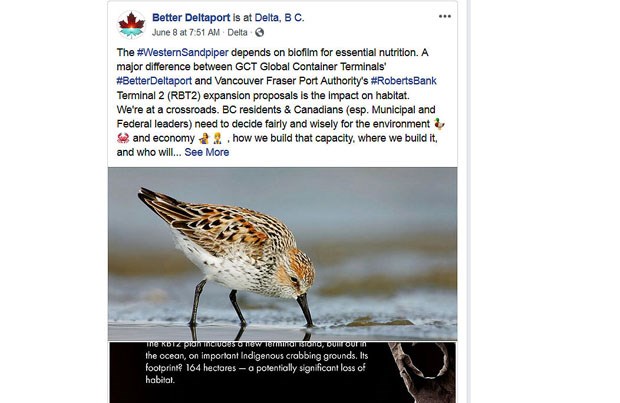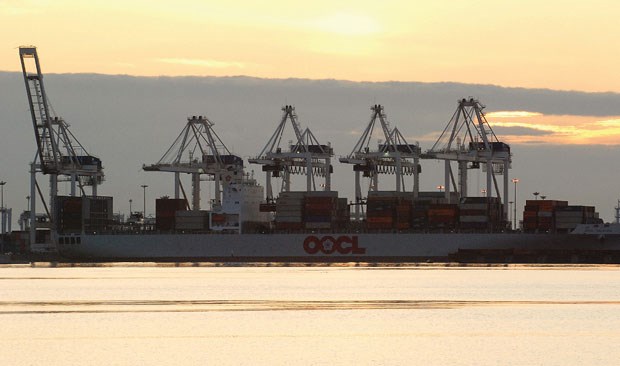Terminal 2 isn’t aimed at fewer jobs.
Duncan Wilson, the Port of Vancouver’s vice-president of government, community and Indigenous affairs, had that to say about Global Container Terminals’ pitch to have a fourth berth built at Deltaport rather than the port authority’s proposed Terminal 2 project.
The operator of the container terminal, GCT continues to be a thorn in the side of the Port of Vancouver with its proposal, launching a #BetterDeltaport campaign to advocate for what it says is a fair review of expansion alternatives at Roberts Bank.
GCT says T2 isn’t viable given changes in a number of market factors and that DP4 is a better alternative.

In an interview with the Optimist, Wilson said that as far as claims being circulated the new terminal, which would have a different terminal operator, would be more automated and have fewer jobs than the existing port, giving the new operator a competitive advantage, Wilson said, “That’s just misinformation, frankly.”
He explained, “We have said repeatedly that we expect Terminal 2 to be semi-automated. GCT’s own plans are semi-automation, so it’s apples-and-apples. We expect about 1,000 or 1,100 longshore jobs at Terminal 2, plus all the inland jobs. Many of those are going to be highly-paid unionized jobs because that’s the nature of those transportation businesses.”
Wilson said having another operator is part of the port’s mandate to ensure it provides facilities that are competitive at reasonable rates to users, so T2 provides an opportunity to bring another terminal operator to the West Coast.
“The reason that is important is because Global Container Terminals has almost three-quarters of the market share in the container sector and that’s an untenable position when you look at what we’re seeing in the growth in containerized trade and constraining capacity. It puts any dominant market player in a position where they are going to be able to extract additional profit at the expense of Canadian consumers and Canadian exporters, particularly those in Western Canada who are dependent on the Vancouver gateway,” he said.
“We’re accountable to the broader public interest and not just shareholders of companies. I think it’s important for the public to understand that difference. When we’re building Terminal 2, we’re not going to be competing with Global Container Terminals. The independent terminal operator that operates Terminal 2 will be competing with Global Container Terminals. I know that GCT has been suggesting that somehow we are in competition with them and we’re not. We are facilitating growth in the port that will bring additional competition,” Wilson said.
GCT’s betterdeltaport.ca website states, “The Vancouver Fraser Port Authority (VFPA) has used its position as regulator to refuse to conduct the necessary environmental review of the Canadian Deltaport Project (GCT Deltaport Berth 4), despite its statutory duty to do so. Instead, VFPA has shortlisted five foreign companies to potentially run its own proposed terminal, RBT2.”
The location of DP4 is a non-starter as well, said Wilson, noting the port authority has worked extensively with GCT over the years on expansion proposals, including the addition of a third berth.
He said the challenges with DP4 include the proposed location, which would see a new terminal within a shallow intertidal habitat.
“We’ve been told in the past by Fisheries and Environment Canada that’s no-go territory. Specifically, we even have a letter from the minister of fisheries directing us to look at options north of the causeway. When we were looking at initial concepts for Terminal 2, at the same time we were looking at the third berth, we had the area east of the causeway where GCT is proposing building as one of the options we looked at for locating Terminal 2. That area was supposed to be filled but couldn’t be because of the intertidal habitat and the high value of the eelgrass, otherwise it would have been optimal to fill that from an operational point of view,” explained Wilson.
Noting T2 would be located in deeper water to minimize impacts to intertidal habitat, it’s the same argument port authority officials discussed with the federal environmental review panel which heard submissions on the T2 application.
Wilson also countered the argument that DP4 and expanding capacity at existing port facilities, including Prince Rupert, will meet container traffic needs, saying expansion elsewhere, including Prince Rupert, will still leave West Coast capacity constrained.
“Notwithstanding what’s happening at Prince Rupert, we’re going to run out of container capacity on the West Coast in the mid-2020s. The only project that is in the hopper that can be delivered in time is Terminal 2, which can be delivered in 2028 or 2029. We filed our environmental impact statement to the government in 2014. If GCT was to move forward, under the new impact assessment act, and they applied to the government for a permit, it would have a much longer timeline.”
GCT this year filed two applications for judicial review related to T2 and the proposed DP4. The applications are anticipated to be heard this September.



